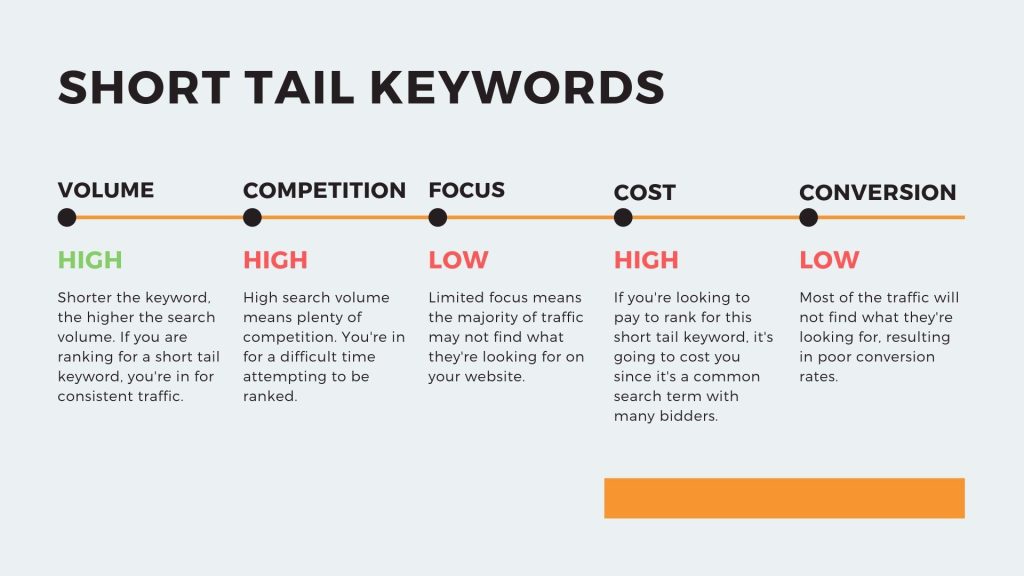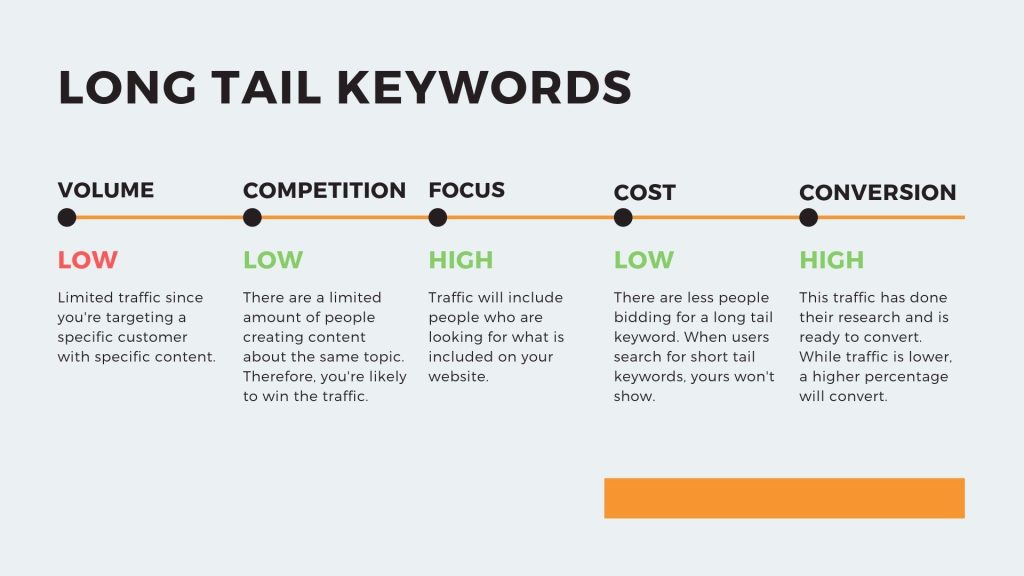In the world of search engine optimization (SEO), short tail and long tail keywords play a crucial role in driving traffic to your website. Understanding the difference between these two types of keywords and knowing which one to target can make a big impact on the success of your SEO strategy.
Short tail keywords are typically one or two words long and are highly general in nature. They are often associated with high search volume and high competition. Examples of short tail keywords include “shoes”, “travel”, and “food”.
On the other hand, long tail keywords are usually three or more words long and are more specific and targeted. They have lower search volume but also lower competition. Examples of long tail keywords include “best running shoes for flat feet”, “budget-friendly travel destinations”, and “vegan food options in Los Angeles”.
The main difference between short tail and long tail keywords is their specificity. Short tail keywords are more general and broad, while long tail keywords are more specific and targeted. This means that while short tail keywords may drive a higher volume of traffic to your website, they may also be more competitive and difficult to rank for. Long tail keywords, on the other hand, may drive less traffic but are often easier to rank for and can lead to more qualified leads.
Short Tail Keywords

Characteristics of short tail keywords:
- Short tail keywords are typically one or two words long.
- They are often associated with high search volume, as they are general and broad terms that many people search for.
- They are also associated with high competition, as many websites will be targeting the same keywords.
Pros and cons of targeting short tail keywords:
- Pros: Short tail keywords can drive a high volume of traffic to your website, which can lead to more visibility and potential customers.
- Cons: The high competition for short tail keywords can make it difficult to rank for them, especially for small and new websites. Additionally, short tail keywords are often not very specific and can attract a lot of irrelevant traffic.
Examples of short tail keywords:
- “Shoes”
- “Travel”
- “Food”
- “Clothes”
- “Fashion”
- “Technology”
- “Fitness”
- “Health”
- “Beauty”
- “Car”
Note: The examples above are broad terms and could be very competitive. It’s recommended to combine them with other words to make it more specific and Long Tail keywords.
Long Tail Keywords

Long tail keywords are phrases or sentences that are more specific and longer than traditional keywords. They typically have lower search volume but are more targeted and have lower competition. This means that they may be easier to rank for in search engine results.
Some characteristics of long tail keywords include:
- Lower search volume: Long tail keywords are more specific and therefore less commonly searched for.
- Lower competition: As a result of lower search volume, there is less competition for long tail keywords among advertisers and website owners.
- More targeted: Long tail keywords are typically more specific and therefore attract more qualified leads.
- Better conversion rates: As a result of being more targeted, long tail keywords can lead to higher conversion rates.
Pros of targeting long tail keywords include:
- Easier to rank for: With lower competition, it may be easier to achieve high rankings for long tail keywords.
- More targeted traffic: Long tail keywords can attract more qualified leads.
- Better conversion rates: As a result of more targeted traffic, long tail keywords can lead to higher conversion rates.
Cons of targeting long tail keywords include:
- Lower search volume: Long tail keywords have lower search volume, which means less traffic potential.
- More work: Finding and targeting long tail keywords can be more time-consuming than targeting traditional keywords.
Examples of long tail keywords include:
- “best running shoes for flat feet”
- “vegan gluten-free chocolate cake recipe”
- “how to clean white leather sneakers”
- “best compact camera for travel”
- “how to build a website with Wordpress”
- “the best digital agency in US”
Which One Should You Target?
When choosing between short tail and long tail keywords, there are a few factors to consider:
- Industry: Different industries will have different characteristics when it comes to short tail and long tail keywords. For example, in a highly competitive industry like technology, it may be more challenging to rank for short tail keywords. However, in a niche industry like handmade soap, long tail keywords may be less relevant.
- Competition: Consider the level of competition for the keywords you are considering. Short tail keywords will typically have higher competition than long tail keywords.
- Budget: Your budget for advertising and SEO will also play a role in your keyword choice. Short tail keywords may require a larger budget for advertising, while long tail keywords can be targeted more effectively with content marketing.
- Search Volume: Consider the traffic potential of each keyword. Short tail keywords will typically have higher search volume, while long tail keywords will have lower search volume.
- Business goals: Lastly, consider what your business goals are. If you are looking to increase brand awareness, short tail keywords may be more beneficial. If you are looking to increase sales, long tail keywords may be more beneficial as they tend to be more specific and have better conversion rates.
When using both short tail and long tail keywords in your SEO strategy, it’s best to:
- Use short tail keywords as the main focus of your SEO strategy and long tail keywords as a supporting element.
- Use long tail keywords in the body of your content, in blog posts, and in meta tags to help improve the relevance of your content for specific searches.
- Use short tail keywords in your page titles, meta descriptions, and headings to help improve the visibility of your content in search results.
- Use a mix of short tail and long tail keywords in your ad campaigns to reach a wider audience and increase the chances of conversion.
- Monitor your analytics to track the performance of your keywords and make adjustments as needed.
- Continuously research and identify new keywords to stay ahead of the competition.
In summary, short tail keywords are more general, higher volume keywords that are more commonly searched for, while long tail keywords are more specific, lower volume keywords that are less commonly searched for but can be more targeted.
When choosing between short tail and long tail keywords, it is important to consider factors such as industry, competition, budget, search volume, and business goals. It’s also recommended to use a mix of both short tail and long tail keywords in your SEO strategy, with short tail keywords as the main focus and long tail keywords as a supporting element.
To optimize your website for search engines using short tail and long tail keywords, consider the following tips:
- Use long tail keywords in the body of your content, in blog posts, and in meta tags to improve the relevance of your content for specific searches.
- Use short tail keywords in your page titles, meta descriptions, and headings to improve the visibility of your content in search results.
- Use a mix of short tail and long tail keywords in your ad campaigns to reach a wider audience and increase the chances of conversion.
- Monitor your analytics to track the performance of your keywords and make adjustments as needed.
- Continuously research and identify new keywords to stay ahead of the competition.
- Utilize On-page SEO techniques such as meta tags, header tags, internal linking, and keyword-rich content.
- Create quality backlinks from authoritative websites to boost your website’s credibility and search engine ranking.
- Regularly update your website’s content and use keywords in a natural and contextually relevant way.
By following these tips, you can optimize your website for search engines and attract more targeted and relevant traffic to your site.



